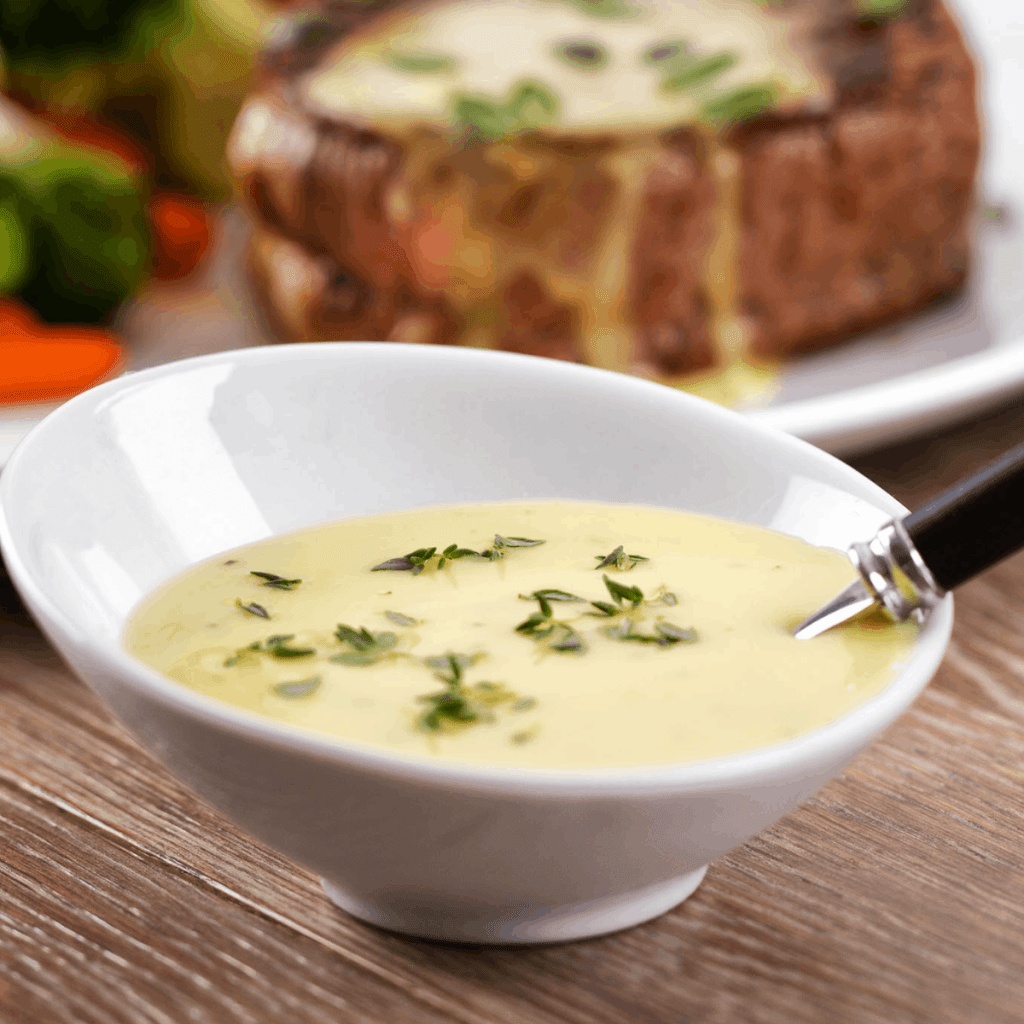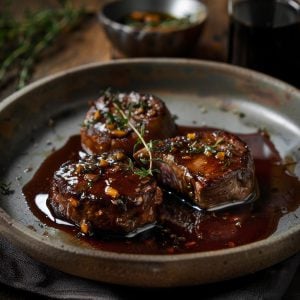How to Prepare Restaurant Quality Béarnaise Sauce
Béarnaise is basically a tarragon-infused hollandaise sauce. Hollandaise is one of the grand or mother sauces of classic French cuisine. It is also one of the most challenging and might take a little practice. But your efforts will be rewarded. This is a decadently delicious sauce.
What Is Béarnaise Sauce?
Béarnaise sauce is a classic French sauce typically served with grilled or roasted meat, particularly steak, and is known for its rich, buttery flavor and creamy texture. The sauce is made by emulsifying egg yolks, butter, vinegar, shallots, and tarragon, resulting in a velvety smooth, and slightly tangy sauce that perfectly complements the savory flavors of the meat.
The history of Béarnaise sauce dates back to the 19th century when French chef Collinet was in the city of Toulouse first created it. It was named after the region of Béarn, located in the southwest of France, where the sauce was believed to have originated. The recipe quickly gained popularity throughout France and eventually made its way to other parts of the world.
Key to Great Béarnaise
The key to making a good Béarnaise sauce is in the emulsification process. First, the egg yolks are whisked together with vinegar and shallots to form a stable base, then slowly incorporated with melted butter to create a smooth and creamy texture. Tarragon, an essential ingredient in the sauce, is added at the end to infuse the sauce with its distinctive flavor.
Béarnaise sauce is often served alongside grilled or roasted beef, but it can also enhance the flavors of other meats, such as chicken and fish. It is also a common ingredient in many classic French dishes, such as Eggs Benedict, served over poached eggs and English muffins.
Despite its rich and indulgent flavor, Béarnaise sauce is relatively easy to make at home with just a few simple ingredients. It can also be customized to suit personal tastes by adjusting the amount of vinegar, shallots, and tarragon used in the recipe. Whether enjoyed in a restaurant or prepared at home, Béarnaise sauce is a timeless classic that adds a touch of French elegance to any meal.
What Do You Serve It With?
Béarnaise sauce is typically served with grilled or roasted meat, particularly steak, and is a popular accompaniment to dishes such as:
- Filet Mignon: This is a tender and flavorful cut of beef often served with Béarnaise sauce to enhance its rich taste.
- Grilled Salmon: Béarnaise sauce can also be served with grilled or roasted fish, and salmon is a popular choice.
- Grilled Chicken: Béarnaise sauce can add a burst of flavor to grilled or roasted chicken, making it a perfect accompaniment to this dish.
- Asparagus: Béarnaise sauce can also be served as a condiment with steamed or grilled vegetables, such as asparagus.
- Poached Eggs: Béarnaise sauce is a critical ingredient in the classic dish Eggs Benedict, served over poached eggs and English muffins.
- Roasted Vegetables: Béarnaise sauce can be used to add a touch of elegance to roasted vegetables like carrots, potatoes, or cauliflower.
- Grilled Shrimp: Béarnaise sauce can be a great complement to seafood dishes like grilled shrimp.
- Beef Wellington: This classic British dish is typically made with beef tenderloin wrapped in puff pastry and served with Béarnaise sauce.
What Does It Taste Like?
Béarnaise sauce has a rich, buttery flavor with a slight tang from the vinegar and shallots used in its preparation. It has a creamy and velvety texture, and adding fresh tarragon gives it a distinct and herbaceous taste.
The combination of flavors is both savory and slightly acidic, making it a perfect accompaniment to grilled or roasted meat, fish, or vegetables. In addition, the buttery flavor of the sauce adds a luxurious and indulgent touch to any dish it is paired with.
Is It Difficult to Prepare?
Béarnaise sauce can be challenging to prepare, especially for novice cooks, but it is not overly complicated. The key to making a good Béarnaise sauce is to pay close attention to the emulsification process and the temperature of the ingredients.
To make this sauce, you will need egg yolks, butter, white wine vinegar, minced shallots, and fresh tarragon. First, the egg yolks are whisked together with the vinegar and shallots over low heat to create a stable base. Melted butter is then slowly added while continuing to whisk the mixture vigorously until the sauce is smooth and creamy. Finally, the tarragon is added, and the sauce is seasoned with salt and pepper to taste.
One of the challenges of making it is the risk of the sauce curdling if the heat is too high or if the butter is added too quickly. It’s essential to keep the heat low and to add the butter gradually to ensure the sauce emulsifies appropriately. Another challenge is keeping the sauce warm without overcooking it, which can cause it to separate.
Can You Store It for Latter Use?
Béarnaise sauce is best served immediately after it is made while it is still warm and creamy. However, it is possible to store Béarnaise sauce for later use if you have leftovers or have prepared the sauce in advance.
To store Béarnaise sauce, transfer it to an airtight container and store it in the refrigerator for up to 2-3 days. When you’re ready to use the sauce, gently reheat it in a double boiler or a microwave on low heat, whisking it frequently to ensure that it heats evenly and does not curdle.
It’s important to note that reheated Béarnaise sauce may not have the same creamy and velvety texture as a freshly made sauce. In addition, the sauce may separate or become grainy, especially if it’s overheated or if it’s been stored for too long. If the sauce has separated, it may be possible to salvage it by whisking in a small amount of warm water or vinegar until the sauce comes back together.
Bearnaise Sauce Recipe
Ingredients
- 1 shallot minced
- 3 ounces tarragon vinegar
- 3 ounces dry white wine
- salt and pepper to taste
- 4 ounces water
- 6 egg yolks
- 12 ounces clarified butter
- 3 tablespoons tarragon chopped
Instructions
- Place the shallot, vinegar, and wine with salt and pepper in a small saucepan and reduce it until it’s almost dry. Add the water and remove from the heat to cool somewhat.
- Strain it if you wish to remove the shallot.
- Place a good-sized stainless steel bowl over another pot with simmering water (a.k.a. a bain-marie). The water in the pot should be low enough so that it does not touch the bottom of the bowl.
- Combine the vinegar, wine, and water mixture and the egg yolks in the bowl.
- Begin whisking incessantly until the yolks form ribbons, lighten in color, and increase in volume. Ensure the heat under the simmering water is not too high but just enough to keep it lightly simmering. Too much heat, and the eggs can begin to scramble.
- You can even briefly remove the bowl from the heat from time to time to limit the temperature.
- Add the butter in increments, constantly whisking. Once the butter is fully incorporated, strain the sauce to remove any coagulated egg particles.
- Finish with the tarragon and additional salt and pepper if necessary.
















